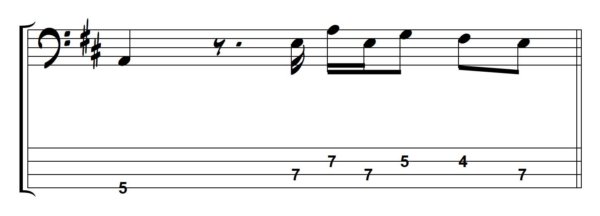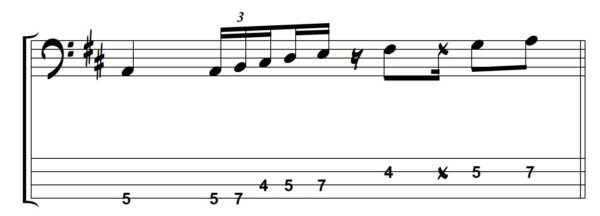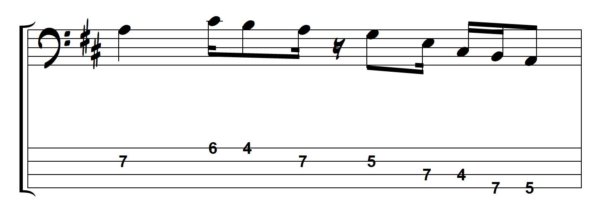In this second lesson on bass fills we’re going to add some scales into the mix. We’ve been playing fills over the A7 chord in our simple progression so we’re going to look at the A Mixolydian scale.
Let’s have a refresher…
In this lesson we’re going to look at how we can use scales to create bass fills over a dominant 7 chord, but the prinicples outlined can be used for playing over any chord.
Just as in the previous lesson we’ll be working over a I-VI-II-V progression in the key of D Major: Dmaj7 – Bm7 – Em7 – A7
Our backing track and bass line are as follows:
We started with Chord Tones
Our fills are going to take place over the A7 chord (fourth bar). Even though we are going to be moving into the world of scales, it’s still important to know the chord tones of the chord we are playing over. The notes of A7 are as follows:
A C# E G
We can play them here within one octave:

Again, if you need any help understanding chord tones or how they relate to the bass fingerboard, be sure to check out the Chord Tone Essentials course. You’ll learn the construction of EVERY chord you’ll ever encounter, how to view them over the entire neck of the bass and how to apply them in your basslines, fills and solos. Click Here For More Information!
The Mixolydian Scale!
The most common scale for use over a dominant 7 chord is the Mixolydian scale. This is a very easy scale to learn. It’s basically a major scale with a flattened 7th degree. The A major scale has the spelling: A B C# D E F# G#. If we flatten the seventh we get the following spelling: A B C# D E F# G.
Here we have a common fingering for an A Mixolydian scale:

We can easily expand on this pattern by adding a few notes above and below (to just cover a little more real estate):

You may also know this scale as the 5th mode of the Major scale. This is true. We are in the key of D major and we are playing a scale from the 5th degree of the key. A Mixolydian is the 5th mode of D Major.
Bass Fill #1
This first bass fill simply works up the A Mixolydian scale and implies a short journey from A up towards our next target of D (in the following bar). Notice how the rhythm is made up of offbeat 16th notes. This helps to increase rhythmic tension.

Bass Fill #2
This bass fill is very similar to the 2nd fill of the previous lesson. We work down from the upper A note, through the A mixolydian scale, again towards our target of D in the next bar.

Bass Fill #3
This fill makes use of a complete mixolydian scale. Take care when playing the 16th note triplet in bear 2. Start out slowly and gradually build up speed.

Bass Fill #4
It’s very important to practice lines starting on notes other than the root note. This fill starts on the 3rd of the chord and then descends through the mixolydian scale. The only non chord tone is our 2nd degree (the B). Again, it’s important to try playing scales in different ways. Don’t just play every note of the scale. Try adding non chord tones in isolation.















Hi Mark, thanks for your great lessons, highly ppreciated.
One question – can I download these backing tracks and if yes, how should I proceed?
Have a nice weeekend
Cees
Thanks for this lesson, and all of them. I’m making a lot of progress, with your help. In this lesson, though, I wish the backing track was quieter, so I could hear the bass more clearly.
just turn your bass up
Hi, Mark. Here is Daniel from Brazil. I have decided to take my bass studies seriously, so your lessons are helping me a lot to organize my studies and I believe they will improve my progress in my bass playing. Great work! God bless.
Hi Mark! Very cool lesson! Easy to follow and positively enlightening. Thank you so much!!